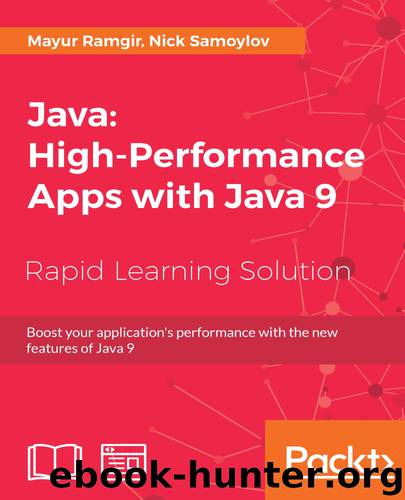Java: High-Performance Apps with Java 9 by Mayur Ramgir

Author:Mayur Ramgir
Language: eng
Format: epub
Publisher: Packt Publishing
These few steps will help you go and create a trial-and-error cycle that will bring you a better understanding of the platform you are using, the needs of your application, and the sensitivity of the JVM and the selected GC to different options. Equipped with this knowledge, you will then be able to meet the nonfunctional performance requirements whether by changing the code, tuning the JVM, or reconfiguring the hardware.
Reactive Programming
After several false starts and a few disastrous disruptions, followed by heroic recoveries, the process of pyramid building took shape and ancient builders were able to complete a few projects. The final shape sometimes did not look exactly as envisioned (the first pyramids have ended up bent), but, nevertheless, the pyramids still decorate the desert today. The experience was passed from generation to generation, and the design and the process were tuned well enough to produce something magnificent and pleasant to look at more than 4,000 years later.
The software practices also change over time, albeit we have had only some 70 years since Mr. Turing wrote the first modern program. In the beginning, when there were only a handful of programmers in the world, a computer program used to be a continuous list of instructions. Functional programming (pushing a function around like a first-class citizen) was introduced very early too but has not become a mainstream. Instead, the GOTO instruction allowed you to roll code in a spaghetti bowl. Structural programming followed, then object-oriented programming, with functional programming moving along and even thriving in certain areas. Asynchronous processing of the events generated by the pressed keys became routine for many programmers. JavaScript tried to use all of the best practices and gained a lot of power, even if at the expense of programmers' frustration during the debugging (fun) phase. Finally, with thread pools and lambda expressions being part of JDK SE, adding reactive streams API to JDK 9 made Java part of the family that allows reactive programming with asynchronous data streams.
To be fair, we were able to process data asynchronously even without this new API--by spinning worker threads and using thread pools and callables (as we described in the previous sections) or by passing the callbacks (even if lost once in a while in the maze of the one who-calls-whom). But, after writing such a code a few times, one notices that most of such code is just a plumbing that can be wrapped inside a framework that can significantly simplify asynchronous processing. That's how the Reactive Streams initiative (http://www.reactive-streams.org) came to be created and the scope of the effort is defined as follows:
The scope of Reactive Streams is to find a minimal set of interfaces, methods and protocols that will describe the necessary operations and entities to achieve the goal--asynchronous streams of data with non-blocking back pressure.
The term non-blocking back pressure is an important one because it identifies one of the problems of the existed asynchronous processing--coordination of the speed rate of the incoming data with the ability of the system to process them without the need of stopping (blocking) the data input.
Download
This site does not store any files on its server. We only index and link to content provided by other sites. Please contact the content providers to delete copyright contents if any and email us, we'll remove relevant links or contents immediately.
Secrets of the JavaScript Ninja by John Resig Bear Bibeault(6635)
Secrets of the JavaScript Ninja by John Resig & Bear Bibeault(6633)
Kotlin in Action by Dmitry Jemerov(5297)
Odoo 15 Development Essentials - Fifth Edition by Daniel Reis & Greg Mader(3663)
Odoo 15 Development Essentials by Daniel Reis(2867)
React Native - Building Mobile Apps with JavaScript by Novick Vladimir(2575)
Pride and Prejudice by Jane Austen(2407)
Learning Angular - Second Edition by Christoffer Noring(2406)
Mobile Forensics Cookbook by Igor Mikhaylov(2067)
Computers For Seniors For Dummies by Nancy C. Muir(2059)
Bulletproof Android: Practical Advice for Building Secure Apps (Developer's Library) by Godfrey Nolan(1917)
Android Development with Kotlin by Marcin Moskala & Igor Wojda(1843)
Building Android UIs with Custom Views by Raimon Ràfols Montané(1837)
1936941139 (N) by Bob Rosenthal(1808)
Android App Development by Franceschi Hervé J.;(1796)
Building Progressive Web Apps: Bringing the Power of Native to the Browser by Ater Tal(1773)
Hands-On Internet of Things with MQTT by Tim Pulver(1765)
Ember.js in Action by Joachim Haagen Skeie(1762)
Hands-On Design Patterns with React Native by Mateusz Grzesiukiewicz(1696)
